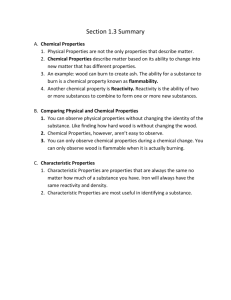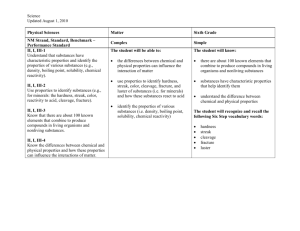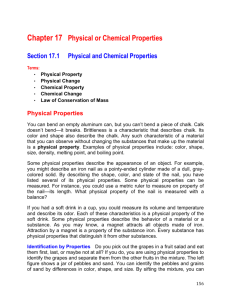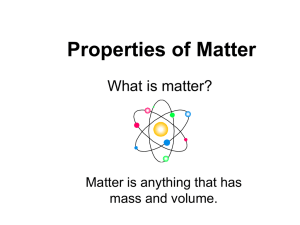Physical Properties A characteristic of a substance that can be
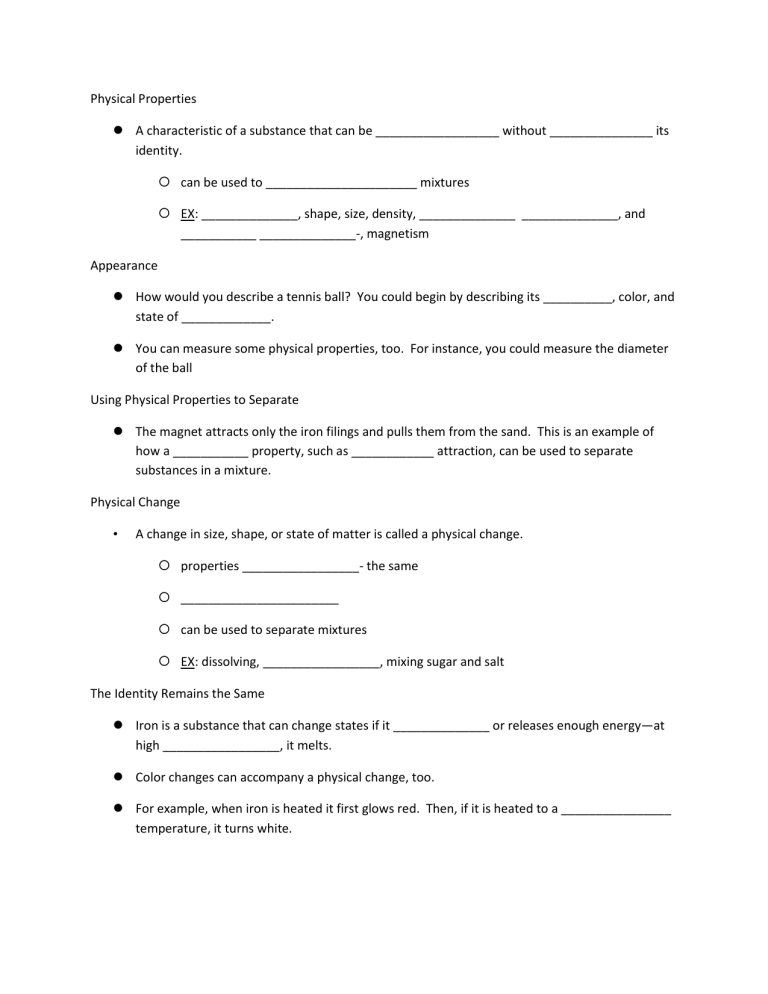
Physical Properties
A characteristic of a substance that can be __________________ without _______________ its identity.
can be used to ______________________ mixtures
EX: ______________, shape, size, density, ______________ ______________, and
___________ ______________-, magnetism
Appearance
How would you describe a tennis ball? You could begin by describing its __________, color, and state of _____________.
You can measure some physical properties, too. For instance, you could measure the diameter of the ball
Using Physical Properties to Separate
The magnet attracts only the iron filings and pulls them from the sand. This is an example of how a ___________ property, such as ____________ attraction, can be used to separate substances in a mixture.
Physical Change
• A change in size, shape, or state of matter is called a physical change.
properties _________________- the same
_______________________
can be used to separate mixtures
EX: dissolving, _________________, mixing sugar and salt
The Identity Remains the Same
Iron is a substance that can change states if it ______________ or releases enough energy—at high _________________, it melts.
Color changes can accompany a physical change, too.
For example, when iron is heated it first glows red. Then, if it is heated to a ________________ temperature, it turns white.
Using Physical Change to Separate
Many such _______________ that lie close to the sea obtain drinking water by using
_____________properties of water to separate it from the salt.
One of these methods, which uses the property of _________________point, is a type of
_______________.
Distillation
The process for separating substances in a mixture by evaporating a liquid and _____________ its vapor is distillation
It usually is done in the __________________ using an apparatus similar to that shown.
Chemical Properties
Characteristic of a substance that indicates whether it can undergo a certain chemical change
________________________, flammability
Signs: color change, __________________of a gas/solid, release of light/heat
EX: reactivity with oxygen, oxygen’s ____________________, a diamond’s resistance to corrosion
Chemical Change
Characteristic of a substance that indicates whether it can undergo a certain
________________change
Reactivity, ______________________
Signs: color change, formation of a gas/solid, release of light/heat
EX: reactivity with oxygen, oxygen’s ________________, a diamond’s resistance to corrosion
The Identity Changes
Clues such as heat, cooling, or the formation of _____________ or solids in a liquid are helpful indicators that a reaction is taking place.
However, the only sure proof is that a new substance is produced.
The only clue that iron has changed into a new substance is the presence of rust.
Using Chemical Change to Seperate
One case where you might separate substances using a _____________change is in cleaning tarnished silver.
___________________ is a chemical reaction between silver metal and sulfur compounds in the air which results in silver sulfide
It can be changed back into silver using a ___________________reaction.
You don’t usually __________________ substances using chemical changes in the home.
In industry and chemical laboratories, however, this kind of separation is common. For example, many metals are __________________- from their ores and then purified using chemical changes.
Weathering –Chemical or Physical
The forces of nature continuously _______________ Earth’s surface. Rocks split, deep canyons are carved out, sand dunes shift, and curious limestone formations decorate caves.
Do you think these changes, often referred to as weathering, are physical or chemical?
The answer is both.
Physical
Large rocks can split when water seeps into small __________________, freezes, and
______________.
However, the smaller pieces of newly exposed rock still have the same properties as the original sample.
This is a _______________ change.
Chemical
Solid calcium carbonate, a compound found in limestone, does not ____________ easily in water.
However, when the water is even slightly _________________, as it is when it contains some dissolved carbon dioxide, calcium carbonate reacts.
It changes into a new substance, calcium hydrogen carbonate, which does ______________ in water.
A similar chemical change produces caves and the icicle shaped rock formations that often are found in them.
The Conservation of Mass
Suppose you ______________a large log until nothing is left but a small pile of ashes.
At first, you might think that matter was lost during this change because the pile of ashes looks much ____________________-- than the log did.
In fact, the mass of the ashes is less than that of the log.
However, suppose that you could collect all the oxygen in the air that was _____________ with the log during the burning and all the smoke and gases that escaped from the burning log and measure their masses, too.
Then you would find that _________________- mass was lost after all.
Not only is no mass lost during burning, mass is not gained or lost during any
______________change.
According to the law of conservation of mass, the ______________of all substances that are present before a ___________________ change equals the mass of all the substances that remain after the change





